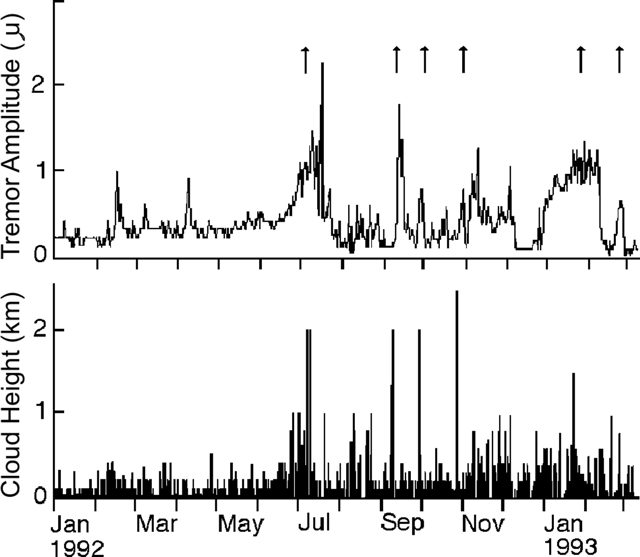Report on Asosan (Japan) — February 1993
Bulletin of the Global Volcanism Network, vol. 18, no. 2 (February 1993)
Managing Editor: Edward Venzke.
Asosan (Japan) Scoria eruption; seismicity declines
Please cite this report as:
Global Volcanism Program, 1993. Report on Asosan (Japan) (Venzke, E., ed.). Bulletin of the Global Volcanism Network, 18:2. Smithsonian Institution. https://doi.org/10.5479/si.GVP.BGVN199302-282110
Asosan
Japan
32.8849°N, 131.085°E; summit elev. 1592 m
All times are local (unless otherwise noted)
The eruptive phase . . . continued through February at Crater 1. At noon on 20 February, vent 922 ejected scoriae to 100 m above the vent, the first eruption observed during daily visits to the crater rim since 22 January. The ejecta, consisting of blocks up to 50 cm across, fell within the 400-m-wide, 150-m-deep crater. Incandescent fountaining, also to a height of 100 m, was observed that night. Inclement weather prevented visual observations in the following days and the ending date for the eruption is not known.
The amplitude of the continuous tremor, which increased in late December, persisted at an elevated level until 10 February, when it rapidly declined (figure 23). The decline was not accompanied by any observed change in surface phenomena. At 0600 on 20 February, the tremor amplitude increased. Tremor amplitude remained high during and after the eruption, abruptly returning to background level at 1215 on 25 February after a small block ejection. An area within 1 km of the crater has been closed since 18 January.
 |
Figure 23. Daily mean amplitude of volcanic tremor (top) and height of steam plume (bottom) at Aso from 1 January 1992 to 8 March 1993. Arrows at the top indicate eruptions. Courtesy of JMA. |
Ash was observed in the steam plume on 1-5, 12-13, 18-20, and 23-25 February. The plume rose to heights of 500 m, increasing briefly to 1,000 m n 19-20 February (figure 23).
Geological Summary. The 24-km-wide Asosan caldera was formed during four major explosive eruptions from 300,000 to 90,000 years ago. These produced voluminous pyroclastic flows that covered much of Kyushu. The last of these, the Aso-4 eruption, produced more than 600 km3 of airfall tephra and pyroclastic-flow deposits. A group of 17 central cones was constructed in the middle of the caldera, one of which, Nakadake, is one of Japan's most active volcanoes. It was the location of Japan's first documented historical eruption in 553 CE. The Nakadake complex has remained active throughout the Holocene. Several other cones have been active during the Holocene, including the Kometsuka scoria cone as recently as about 210 CE. Historical eruptions have largely consisted of basaltic to basaltic-andesite ash emission with periodic strombolian and phreatomagmatic activity. The summit crater of Nakadake is accessible by toll road and cable car, and is one of Kyushu's most popular tourist destinations.
Information Contacts: JMA.

